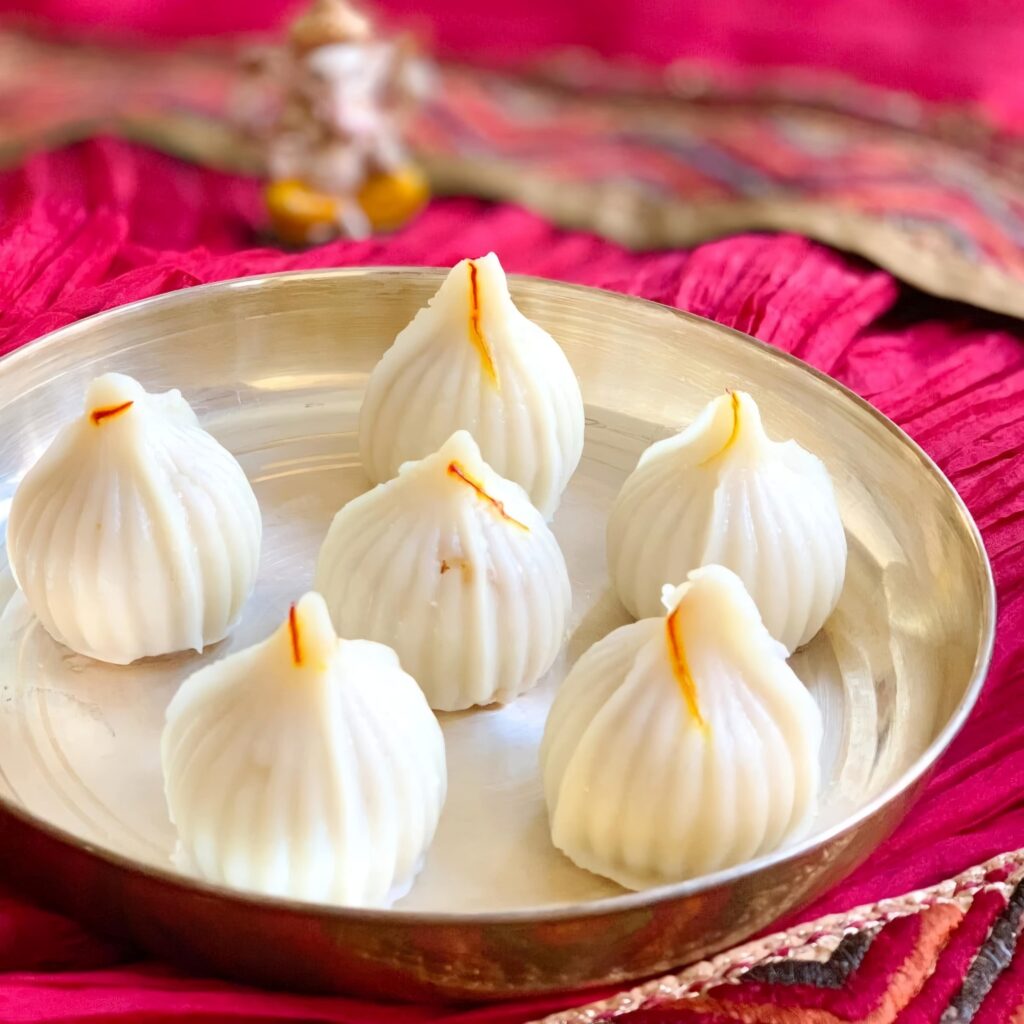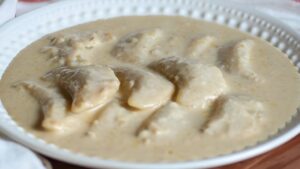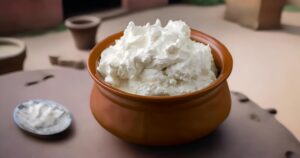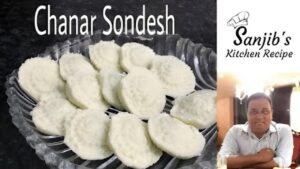Delicious Steamed Modak Recipe

Modak, a sweet dumpling, holds a special place in Indian culinary traditions, particularly in Maharashtra, where it is closely associated with the festival of Ganesh Chaturthi. This delicacy is believed to be a favorite of Lord Ganesha, the elephant-headed deity, and is offered to him as a form of devotion. Modaks come in various forms, but the steamed variety, known as “Ukadiche Modak,” is particularly cherished for its soft, melt-in-the-mouth texture and the fragrant, sweet filling made of fresh coconut and jaggery. In this recipe, we will delve into the traditional method of making Rice Flour and Coconut Steamed Modak, exploring each step in detail to ensure that even beginners can master this revered treat.
Ingredients
For the Outer Covering:
- 1 cup rice flour
- 1 ¼ cups water
- 1 teaspoon ghee (clarified butter)
- A pinch of salt
For the Filling:
- 1 cup freshly grated coconut
- ¾ cup jaggery, grated or chopped finely
- 1 teaspoon ghee
- ½ teaspoon cardamom powder
- 1 tablespoon poppy seeds (optional)
- A pinch of nutmeg powder (optional)
Preparation
Step 1: Preparing the Filling
- The filling, known as saran, is the heart of the modak. It is a fragrant mixture of grated coconut, jaggery, and spices that infuses the modak with its signature flavor.
- Heating the Pan: Begin by heating a heavy-bottomed pan on medium flame. Add 1 teaspoon of ghee to the pan. Ghee is used here not only for its flavor but also to prevent the jaggery from sticking to the pan.
- Toasting the Poppy Seeds: If you’re using poppy seeds, lightly toast them in the ghee until they are fragrant and turn a light golden color. This step is optional, but it adds a nutty flavor and a slight crunch to the filling.
- Cooking the Coconut and Jaggery: Add the freshly grated coconut to the pan and sauté for about 2-3 minutes until it begins to release its aroma. Then, add the jaggery. Stir the mixture continuously until the jaggery melts completely and blends with the coconut. The mixture should be moist but not watery. If it’s too dry, the filling may become crumbly.
- Adding Spices: Once the jaggery is well incorporated, add the cardamom powder and nutmeg powder. Stir well to evenly distribute the spices. Cook the mixture for another 2-3 minutes, then remove from heat and let it cool. The filling will thicken as it cools.
Step 2: Preparing the Rice Dough
- The outer covering of the modak, known as ukad, is made from rice flour. This step requires precision to achieve a dough that is smooth, pliable, and free from cracks.
- Boiling Water: In a deep pan, bring 1 ¼ cups of water to a boil. Add a pinch of salt and 1 teaspoon of ghee to the water. The salt enhances the flavor of the dough, while the ghee helps in making it soft and pliable.
- Adding Rice Flour: Lower the heat to the minimum and gradually add the rice flour to the boiling water, stirring continuously to avoid lumps. The stirring process is crucial; any lumps in the dough will make it difficult to shape the modaks.
- Cooking the Dough: Once all the rice flour is incorporated, cover the pan with a lid and let it steam on low heat for about 2 minutes. This helps to cook the rice flour thoroughly, which is essential for a smooth dough.
- Kneading the Dough: After 2 minutes, remove the pan from heat and transfer the dough onto a clean, flat surface or into a large mixing bowl. While the dough is still warm (but not hot), knead it gently for about 5-7 minutes until it becomes smooth and free of cracks. If the dough feels too dry, sprinkle a little warm water and knead again. If it’s too sticky, dust your hands with a little rice flour and continue kneading. The consistency of the dough should be soft, smooth, and non-sticky.
Step 3: Shaping the Modak
- Shaping modaks is an art that requires some practice, but with patience and a gentle hand, you can create beautiful, traditional modaks.
- Dividing the Dough: Divide the dough into small, equal-sized balls, roughly the size of a small lime. Keep the dough balls covered with a damp cloth to prevent them from drying out.
- Shaping the Dough: Take one dough ball and flatten it into a small disc using your fingers. You can grease your fingers with a little ghee to prevent the dough from sticking. The edges of the disc should be thinner than the center. This ensures that the modak has an even thickness, and the base is strong enough to hold the filling.
- Creating the Pleats: Place a small amount of the coconut-jaggery filling in the center of the disc. Start pinching the edges of the disc to form pleats, working your way around the edge. Traditional modaks have around 8-10 pleats, but you can make more or fewer depending on your skill level. Once all the pleats are made, bring them together at the top to seal the modak. Gently pinch and twist the top to secure it. Ensure that there are no cracks, as they can cause the modak to break open while steaming.
- Alternative Method Using a Modak Mould: If you find it challenging to shape the modaks by hand, you can use a modak mould. Grease the inside of the mould with a little ghee, place a dough ball inside, press it to the sides to form a hollow, fill it with the coconut-jaggery mixture, and seal the bottom with a small piece of dough. Open the mould carefully to release the shaped modak.
Step 4: Steaming the Modak
- Steaming is a critical step in the process. It gives the modak its soft, chewy texture.
- Preparing the Steamer: Fill a steamer or a large pot with water and bring it to a boil. You can use an idli steamer, a bamboo steamer, or even a large pan with a trivet at the bottom. Line the steamer basket or plate with a banana leaf, muslin cloth, or parchment paper to prevent the modaks from sticking.
- Steaming the Modak: Place the modaks in the steamer, making sure they are not touching each other. Cover the steamer with a lid. If your lid isn’t tight-fitting, you can wrap a kitchen towel around it to ensure that the steam doesn’t escape. Steam the modaks for about 10-15 minutes on medium heat. You’ll know they’re done when they turn slightly translucent, and the outer covering is firm to the touch.
- Resting the Modak: Once steamed, remove the modaks from the steamer and let them rest for a few minutes. This resting period allows them to firm up slightly and makes them easier to handle.
Serving the Modak
Modaks are best enjoyed fresh, while they’re still warm. The soft rice flour covering contrasts beautifully with the sweet, fragrant filling. Traditionally, modaks are served with a drizzle of ghee on top, which enhances their flavor and gives them a glossy finish.
Storing the Modak
If you have leftovers, you can store the modaks in an airtight container at room temperature for up to a day. For longer storage, refrigerate them for up to 2 days. To reheat, steam them again for a few minutes until they’re soft and warm.
Tips and Variations
- Choosing the Right Rice Flour: For the best results, use fine rice flour specifically meant for modaks. Coarse flour will result in a gritty texture. You can find rice flour labeled as “modak flour” or “idiyappam flour” in Indian grocery stores.
- Adjusting the Sweetness: The sweetness of the filling can be adjusted according to your taste. Some prefer a sweeter filling, while others like it less sweet. Taste the filling while cooking, and add more jaggery if needed.
- Adding Nuts and Raisins: For an extra layer of texture and flavor, you can add chopped nuts like cashews, almonds, or raisins to the filling. Lightly toast them in ghee before adding them to the coconut-jaggery mixture.
- Flavoring the Dough: Some variations of modak use flavored rice dough. You can add a pinch of saffron soaked in warm milk or a few drops of rose water to the dough for a subtle flavor.
Conclusion
Making Rice Flour and Coconut Steamed Modak is not just about following a recipe; it’s about connecting with a tradition that has been passed down through generations. The process may seem intricate, but each step is an opportunity to immerse yourself in the rich cultural heritage that these sweet dumplings represent. Whether you’re preparing them as an offering for Ganesh Chaturthi or as a treat for your family, the effort you put into making these modaks will be well worth it when you see the smiles they bring to everyone’s faces.
Here are some Frequently Asked Questions (FAQs) based on the Rice Flour and Coconut Steamed Modak recipe:
-
What is Modak, and why is it significant?
Modak is a traditional Indian sweet dumpling, often associated with the festival of Ganesh Chaturthi, where it is offered to Lord Ganesha. It is particularly popular in Maharashtra. The steamed variety, known as “Ukadiche Modak,” is especially cherished for its soft texture and flavorful filling of coconut and jaggery.
-
What type of rice flour should I use for Modak?
For the best results, use fine rice flour specifically labeled as “modak flour” or “idiyappam flour,” which is available in Indian grocery stores. Coarse rice flour may result in a gritty texture, which is not ideal for Modak.
-
Can I use store-bought coconut instead of fresh coconut?
Yes, you can use store-bought grated coconut, but fresh coconut is preferred for its natural sweetness and flavor. If using frozen coconut, make sure to thaw and drain any excess moisture before using it in the recipe.
-
How do I prevent the Modak dough from cracking?
Ensure that the dough is kneaded well while it’s still warm. If the dough feels too dry, add a little warm water and knead again. If it’s too sticky, dust your hands with rice flour and continue kneading until it’s smooth and pliable. Cover the dough balls with a damp cloth to prevent them from drying out while shaping the Modaks.
-
What can I do if my Modak cracks during steaming?
Cracking usually occurs if the dough is too dry or not kneaded enough. To avoid this, make sure the dough is soft and smooth before shaping the Modaks. Additionally, ensure that the edges of the Modak are sealed properly before steaming.
-
Can I make Modaks without a mould?
Yes, Modaks can be shaped by hand. Simply flatten the dough into a disc, add the filling, and pleat the edges to form a Modak. However, if you find this challenging, using a mould can make the process easier and more uniform.
-
How long should I steam the Modaks?
Steam the Modaks for about 10-15 minutes on medium heat. You’ll know they are done when they turn slightly translucent, and the outer covering is firm to the touch. Avoid over-steaming, as this can make the Modaks tough.
-
Can I add any other ingredients to the filling?
Yes, you can add chopped nuts like cashews or almonds, or even raisins, to the filling for extra texture and flavor. Some people also like to add a pinch of saffron or rose water to the filling for a fragrant twist.
-
How should I store leftover Modaks?
Modaks can be stored in an airtight container at room temperature for up to a day. For longer storage, refrigerate them for up to 2 days. To reheat, steam them again for a few minutes until they’re soft and warm.
-
What should I serve with Modaks?
Modaks are traditionally served with a drizzle of ghee on top. The ghee enhances the flavor and adds a rich, buttery taste to the Modaks.
-
Can I make Modaks in advance?
Yes, you can prepare the filling and the dough in advance. Store the filling in the refrigerator and the dough at room temperature, covered with a damp cloth. Shape and steam the Modaks just before serving to enjoy them fresh.
-
Are there any variations to the traditional Modak?
Yes, there are several variations. You can flavor the dough with saffron or rose water, or use alternative fillings like dry fruits or chocolate. However, the coconut-jaggery filling remains the most traditional and popular.
-
What should I do if the jaggery in the filling crystallizes?
Crystallization can occur if the jaggery is overcooked or if the heat is too high. To prevent this, cook the jaggery and coconut mixture on medium heat and stir continuously. If it does crystallize, you can add a tablespoon of water and reheat the mixture gently to dissolve the crystals.
-
Can I use a microwave to reheat Modaks?
It’s best to reheat Modaks by steaming them again to retain their soft texture. Microwaving can make them tough and chewy.
-
What is the purpose of adding ghee to the dough and filling?
Ghee adds a rich flavor and helps in making the dough soft and pliable. It also prevents the jaggery from sticking to the pan while making the filling.







